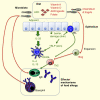Mucosal immunology of food allergy
- PMID: 23660362
- PMCID: PMC3667506
- DOI: 10.1016/j.cub.2013.02.043
Mucosal immunology of food allergy
Abstract
Food allergies are increasing in prevalence at a higher rate than can be explained by genetic factors, suggesting a role for as yet unidentified environmental factors. In this review, we summarize the state of knowledge about the healthy immune response to antigens in the diet and the basis of immune deviation that results in immunoglobulin E (IgE) sensitization and allergic reactivity to foods. The intestinal epithelium forms the interface between the external environment and the mucosal immune system, and emerging data suggest that the interaction between intestinal epithelial cells and mucosal dendritic cells is of particular importance in determining the outcome of immune responses to dietary antigens. Exposure to food allergens through non-oral routes, in particular through the skin, is increasingly recognized as a potentially important factor in the increasing rate of food allergy. There are many open questions on the role of environmental factors, such as dietary factors and microbiota, in the development of food allergy, but data suggest that both have an important modulatory effect on the mucosal immune system. Finally, we discuss recent developments in our understanding of immune mechanisms of clinical manifestations of food allergy. New experimental tools, particularly in the field of genomics and the microbiome, are likely to shed light on factors responsible for the growing clinical problem of food allergy.
Copyright © 2013 Elsevier Ltd. All rights reserved.
Figures



References
-
- Caubet JC, Nowak-Wegrzyn A. Current understanding of the immune mechanisms of food protein-induced enterocolitis syndrome. Expert Rev Clin Immunol. 2011;7:317–327. - PubMed
-
- Abonia JP, Rothenberg ME. Eosinophilic esophagitis: rapidly advancing insights. Annu Rev Med. 2012;63:421–434. - PubMed
-
- Sicherer SH. Epidemiology of food allergy. J Allergy Clin Immunol. 2011;127:594–602. - PubMed
-
- Chafen JJ, Newberry SJ, Riedl MA, Bravata DM, Maglione M, Suttorp MJ, Sundaram V, Paige NM, Towfigh A, Hulley BJ, et al. Diagnosing and managing common food allergies: a systematic review. JAMA. 2010;303:1848–1856. - PubMed
Publication types
MeSH terms
Substances
Grants and funding
LinkOut - more resources
Full Text Sources
Other Literature Sources
Medical

